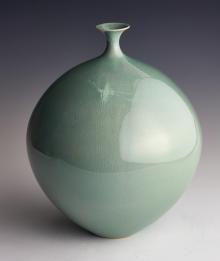Back
Korean Ceramic Culture: Legacy of Earth and Fire
SHIN Sang ho (born 1947). Round Bottle with Slender Flaring Neck and Flying Crane Decoration. Korean; Republican period, circa 1973. Inlaid celadon ware: light gray stoneware with celadon glaze over decoration inlaid in white slip, 11 x 8 inches. Gift of John and Kyungsook Cho Gregor in memory of Chee Shik Shin and Hai Soon Cho.
Conical Bowl with Stylized Floral Arabesque Design. Korean; Goryeo dynasty, late 12th century. Light gray stoneware with celadon glaze over decoration inlaid in black and white slips, 2-3/4 x 6-5/8 inches. Murray Warner Collection.
Korean Ceramic Culture: Legacy of Earth and Fire
January 10, 2021 to May 22, 2022
As a teaching museum, the JSMA is dedicated to helping students develop meaningful, life-long connections with art. In addition to regular museum visits and classes, we periodically receive grants that allow us to host scholars with a deeper research focus. In Fall 2019, Bokyoung Hong, a specialist in Korean ceramics, came to the JSMA for a 10-month Korea Foundation Global Challengers internship. One of a handful of young scholars sent abroad by the Korean government, Hong spent six months researching the JSMA collection to plan the exhibition Korean Ceramic Culture: Legacy of Earth and Fire. A highlight of her work was the opportunity it afforded to study Korean celadon ceramics, regarded even by early Chinese connoisseurs as “first under heaven."
Characterized by naturalistic shapes, incised, carved, or inlaid decoration, and luminous light bluish-green glazes, Korean celadons of the Goryeo dynasty (918-1392) are celebrated as the pinnacle of elegance and sophistication (Lobed Circular Bowl, 1999:2.2). Korean potters took inspiration from northern Chinese celadon glazes but refined their techniques and materials from the ninth through the twelfth centuries. One new technique they developed was inlaid decoration, in which white or black slip (diluted clay) was used to fill indentations carved into the surface of the ceramic body before it was covered with glaze. After firing, the slip created underglaze pictorial designs. A In addition to a more typical Korean inlaid celadon, is the Horn Cup with Chrysanthemum Design (1993:4), whereas a remarkably rare and important example is the late twelfth-century Conical Bowl with Stylized Floral Arabesque Design; its interior decoration employs the most coveted “reverse-inlay” technique, in which the ground around the swirling, cloud-like leaves are outlined by slip (rather than the leaves themselves) was carefully being inlaid with it. A strikingly similar bowl in the National Museum of Korea is designated as National Treasure No. 115.
A number of works in the exhibition were donated by local collector Kyungsook Cho Gregor, who over the last 35 years has gifted over 200 Korean objects to the museum, including 18 unglazed earthenware and stoneware vessels and rooftiles dating from the Three Kingdoms (57 BCE-935 CE) and Unified Silla (668-918) periods. Gregor and her husband also donated a series of photographs by KIM Geun Won (1922-2000), some of which are featured in the exhibition. A stunning contemporary celadon Bottle from the Gregors’ collection was created by SHIN Sang-ho (born 1947), former Dean of the College of FineArts at Hongik University in Seoul. With its dramatic silhouette, lacy craquelure, and graceful inlaid crane, this exquisite vessel both pays homage to and updates the Goryeo celadon tradition. The Gregors are graciously donating it in memory of two women who embodied grace and fearless determination: author Chee Shik Shin (a cousin of the artist) and Gregor’s niece, Hai Soon Cho.







